Asus ROG Phone 8 Pro review: grown-up gamer
Epic gaming performance meets AI-assisted camera cleverness
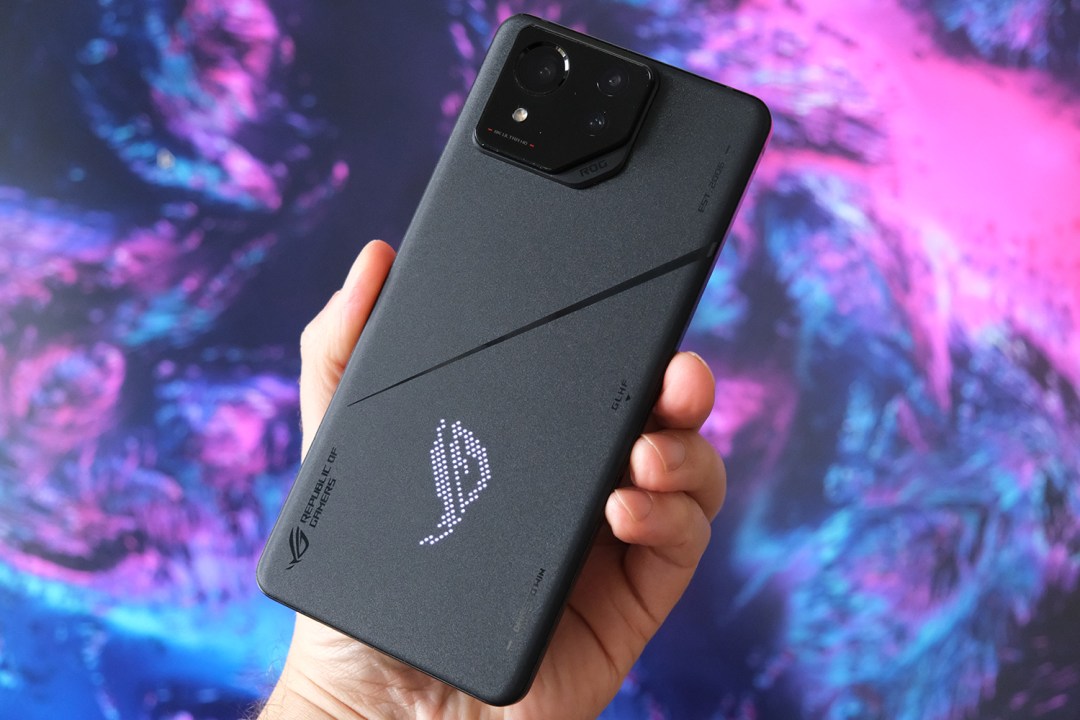
Stuff Verdict
The Asus ROG Phone 8 Pro’s slicker styling blurs the line between gaming phone and all-rounder flagship. Not all the upgrades land successfully, but there’s no denying the performance on tap.
Pros
- Gaming-grade power, with or without accessories
- Camera hardware sees welcome upgrades
- New look is a more mature take on the gaming phone formula
Cons
- Loses a few fan-favourite features
- ROG Phone 8 Pro Edition bundle is mighty pricey
Introduction
All-rounder handsets tend to claim the top spots on Stuff’s best smartphone lists, but I’ll always point serious mobile gamers towards dedicated hardware. Unrivalled performance, wider accessory support and bigger batteries are usually worth paying a premium for, even if gaming phones haven’t historically delivered cameras that matched their high prices. The Asus ROG Phone 8 Pro wants to change that.
The sequel to 2023’s mighty powerful ROG Phone 7 Ultimate doubles down on photography hardware, and dresses in more businesslike attire than any previous iteration. But that doesn’t mean Asus has forgotten its core fanbase. Qualcomm’s latest and greatest mobile silicon should guarantee high frame rates, and the optional AeroActive Cooler accessory will keep it cool under pressure. Buy the top-tier ROG Phone 8 Pro Edition directly from the Asus web store and you even get one in the box.
Have some fan favourite features been sacrificed in the name of mass market appeal, though? Do those cameras cut the mustard against more mainstream rivals? And most importantly, with mobile CPUs no longer the furnaces they once were, do you need a dedicated gaming phone at all?
How we test smartphones
Every phone reviewed on Stuff is used as our main device throughout the testing process. We use industry standard benchmarks and tests, as well as our own years of experience, to judge general performance, battery life, display, sound and camera image quality. Manufacturers have no visibility on reviews before they appear online, and we never accept payment to feature products.
Find out more about how we test and rate products.
Design & build: all grown up
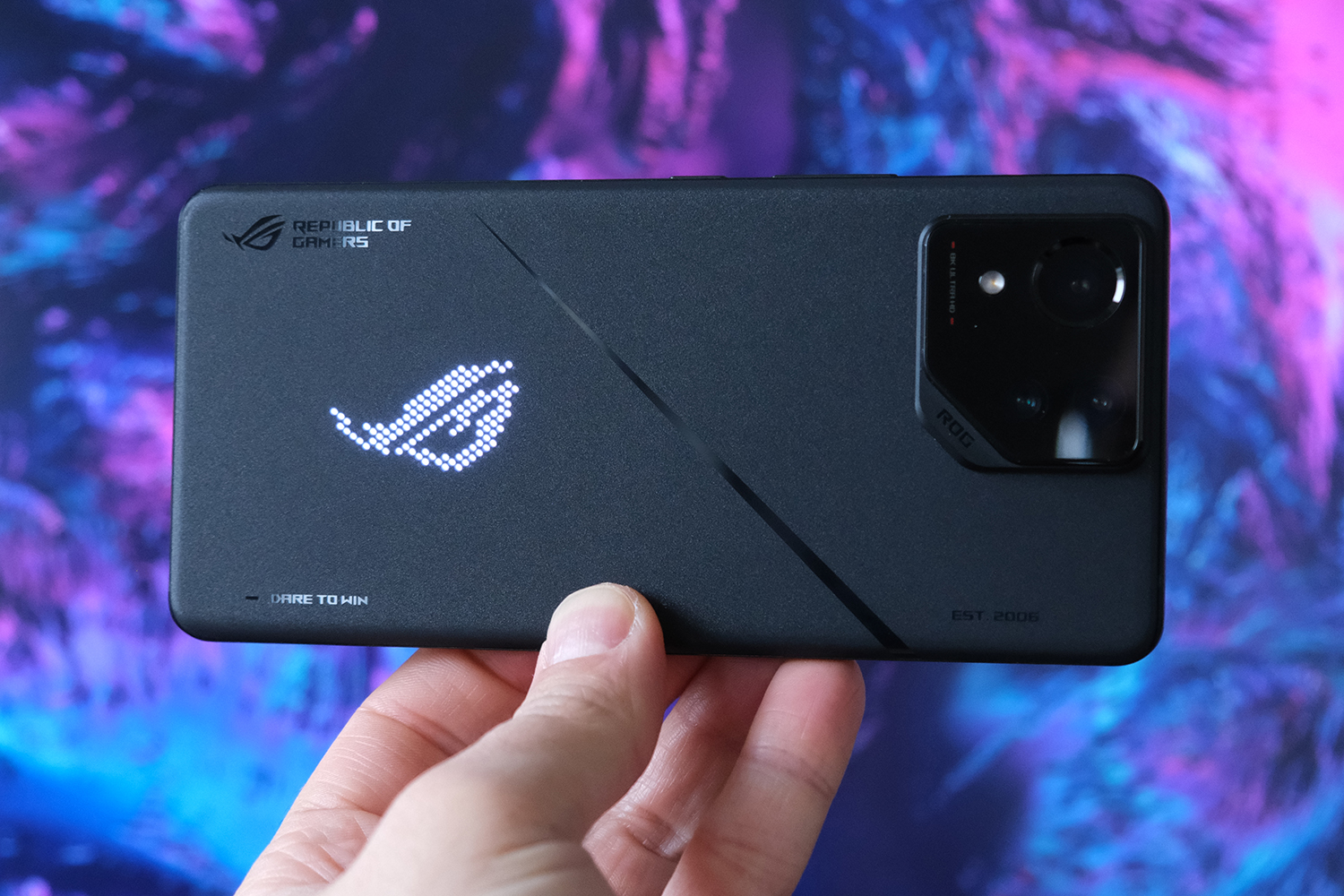
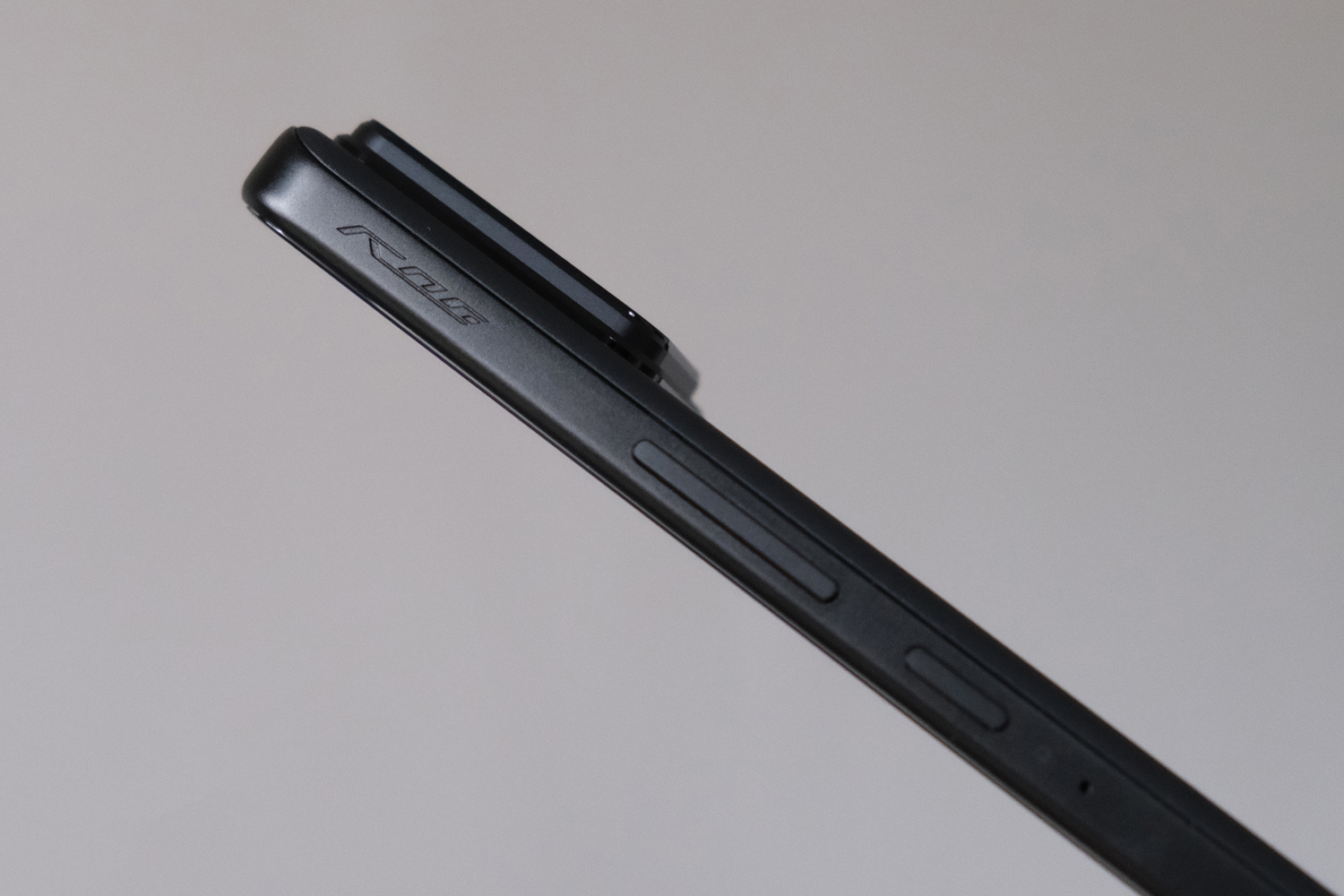
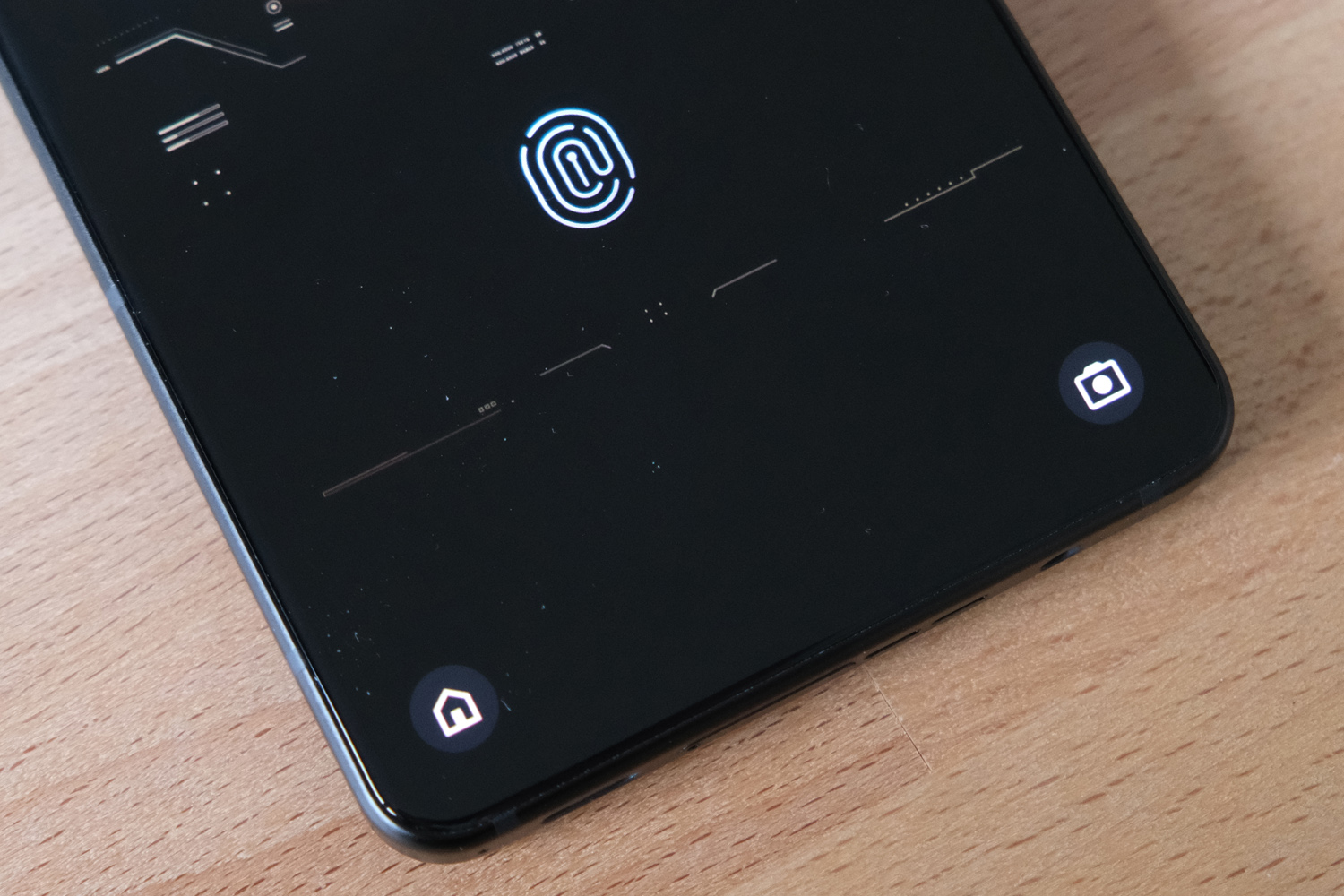
The newest ROG Phone comes in two flavours; the regular Phone 8 and the Phone 8 Pro. I was sent the latter, in top-tier Edition guise, complete with bundled AeroActive Cooler add-on. Styling is a lot less ‘gamer’ than previous years, whichever you go for, with more subtle colour schemes and branding. A metal frame and glass rear give proper flagship vibes.
That’s not to say Asus has resisted the allure of RGB. The regular Phone 8 gets an illuminated ROG logo on the rear, beneath the angular camera module that protrudes a fair way out from the phone body. The Phone 8 Pro swaps the logo for an AniMe Vision panel made up of mini-LEDs. Expect eye-catching custom animations and useful info with it enabled; with it switched off I found it impossible to spot where the frosted glass rear ended and the display began. I love how it shows a camera icon when you’re taking pictures, and displays the time or remaining battery when sat on my desk.
The ROG Phone 8 Pro is a heck of a lot slimmer than last year’s Phone 7 Ultimate. At 8.9mm it’s on par with more mainstream flagships, and the screen bezels are slimmer too. At 225g it’s only slightly heavier than an iPhone 15 Pro Max, which uses titanium to keep weight down. Even better, Asus has made the whole thing IP68 water resistant for the first time.
That means there’s no active exhaust flap any more, but a redesigned cooling system and larger, more effective AeroActive Cooler accessory should mean heat isn’t a problem. Asus says its 29% quieter than last year’s effort, while also being 10% lighter and even more power efficient. I was certainly able to play without headphones, and had no complaints from my partner while next to her on the sofa.
I’m happy to see dual USB-C ports make a return, even if the one at the bottom of the phone is still off-centre. That can mean some third-party accessories just won’t work. On the other hand, it means being able to charge the phone comfortably while gaming, gives the cooler somewhere to plug in to, and also lets you charge while listening through USB-C headphones. A 3.5mm headphone port means regular wired earphones are still supported, too.
Asus’ touch-sensitive air triggers are also back, for a slicker gaming experience without reaching for a third-party controller.
Screen & sound: see the light
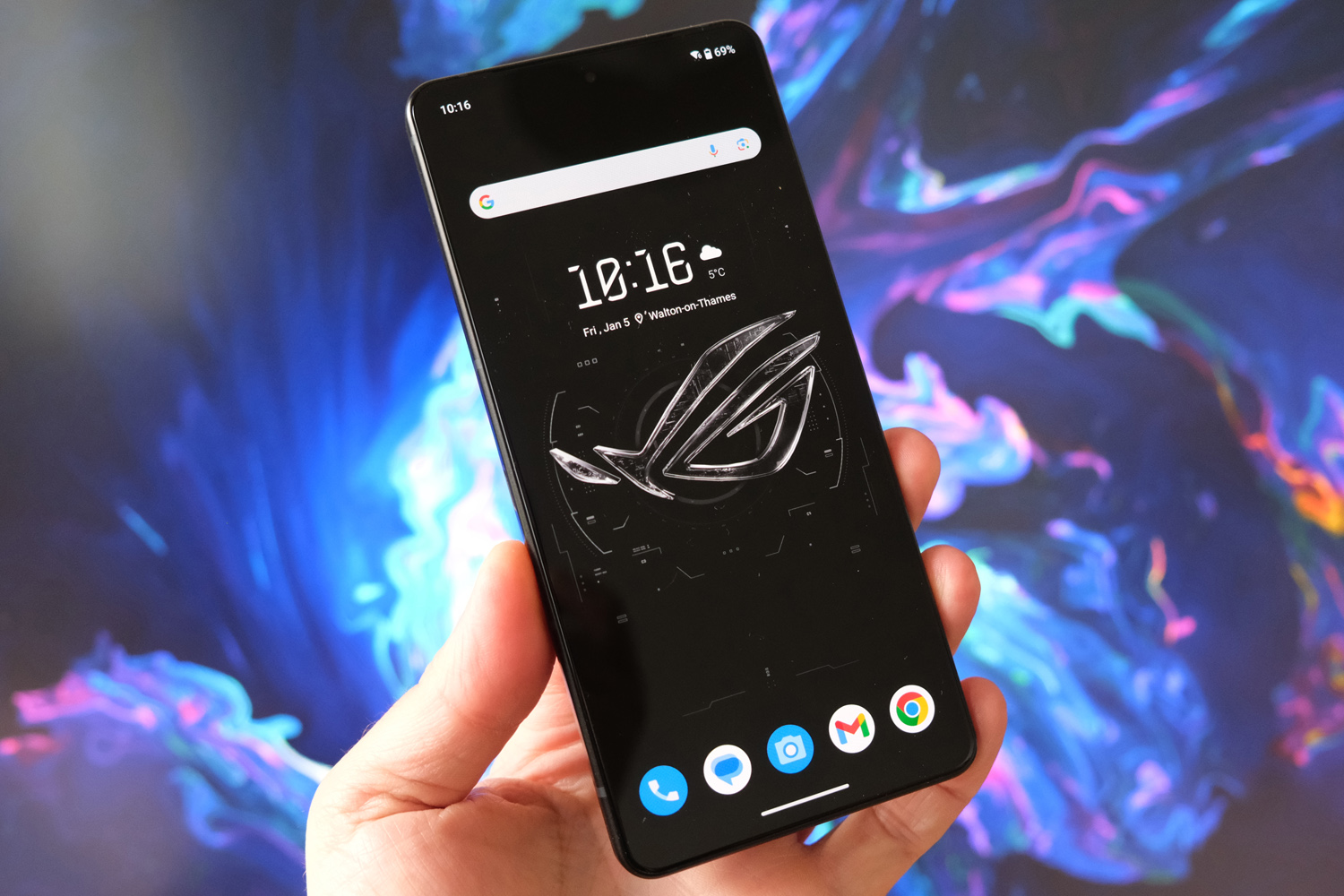
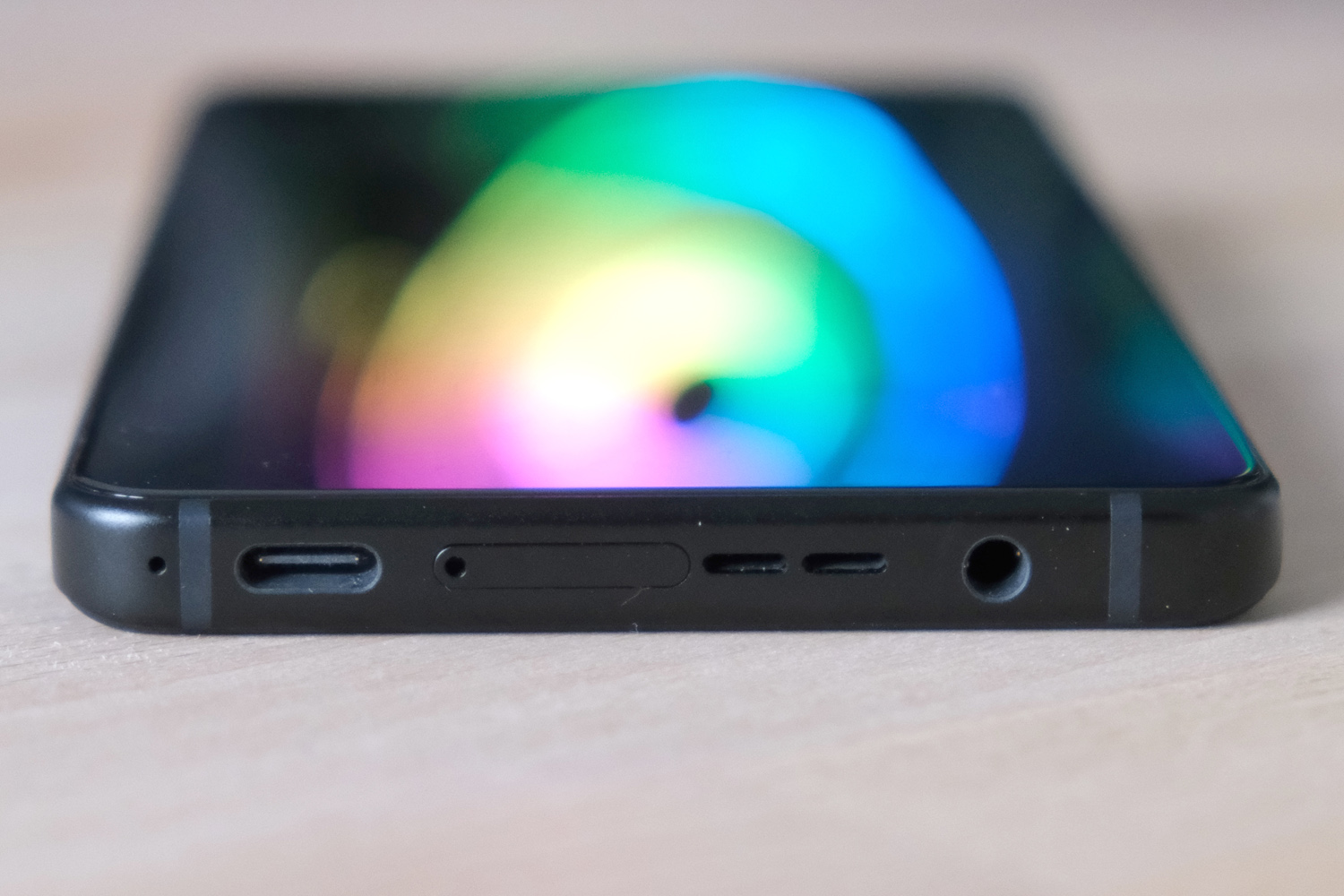
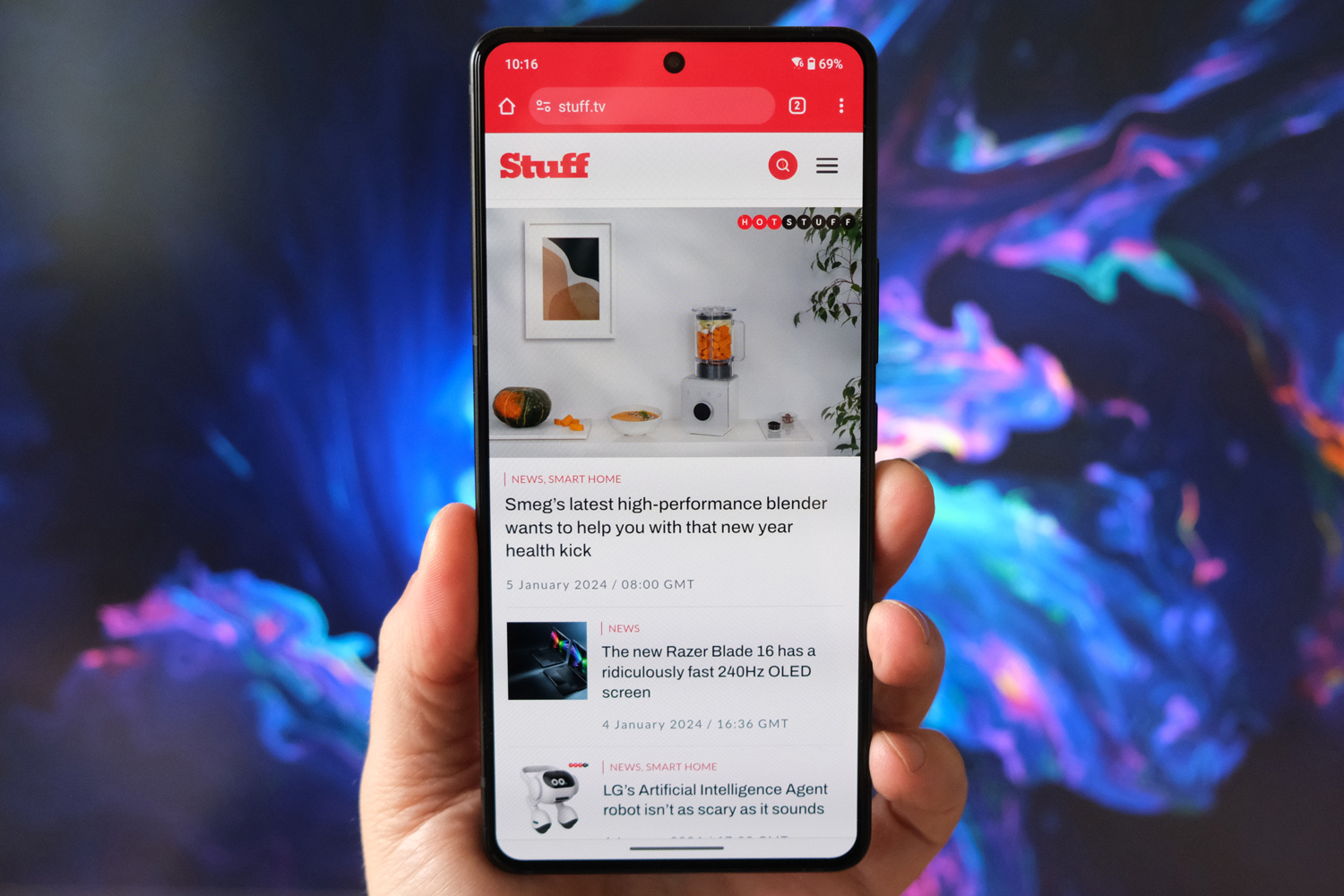
With a 6.78in OLED panel and gamer-friendly 165Hz maximum refresh rate, you’d be forgiven for thinking Asus hadn’t really changed up the display between ROG Phone generations. Dig deeper, though, and you’ll spot a few welcome upgrades.
There’s now LTPO adaptive refresh tech when you’re not gaming, switching from 1-120Hz on the fly with any onscreen movement, and brightness has taken a major step up. It can now hit a peak 2500 nits, which is a huge leap from the ROG Phone 7 Ultimate’s 1500nit maximum. That made outdoor viewing a breeze, even on the sunniest of days.
The display bezels have also shrunk on all four sides – so much so there’s no room for a front-facing webcam inside the remaining sliver, or dual front-facing speakers. Asus has gone with a punch-hole cam instead. Software can force games to ignore that part of the screen, in case you find it distracting, but I think many gamers will see this is a huge compromise.
Contrast levels are exceptional, as I’d expect from OLED tech, and colours are wonderfully vibrant. The 2400×1080 resolution looks decently sharp stretched across 6.78in, and means the chipset doesn’t have to work quite as hard in games as it might had Asus gone for a QHD+ panel. Games and videos have ample dynamic range, and support for most HDR formats. Only Dolby Vision is MIA.
I’m in no doubt audio has taken a backwards step here, with a down-firing main speaker and front-firing earpiece tweeter instead of the dual front speakers seen on older ROG phones. Volume takes a hit as a result, and you need to cup the phone in your palm for more convincing stereo audio. Clarity is decent enough, with a clear vocal range, but it no longer beats non-gaming phones.
Cameras: tempting trio?
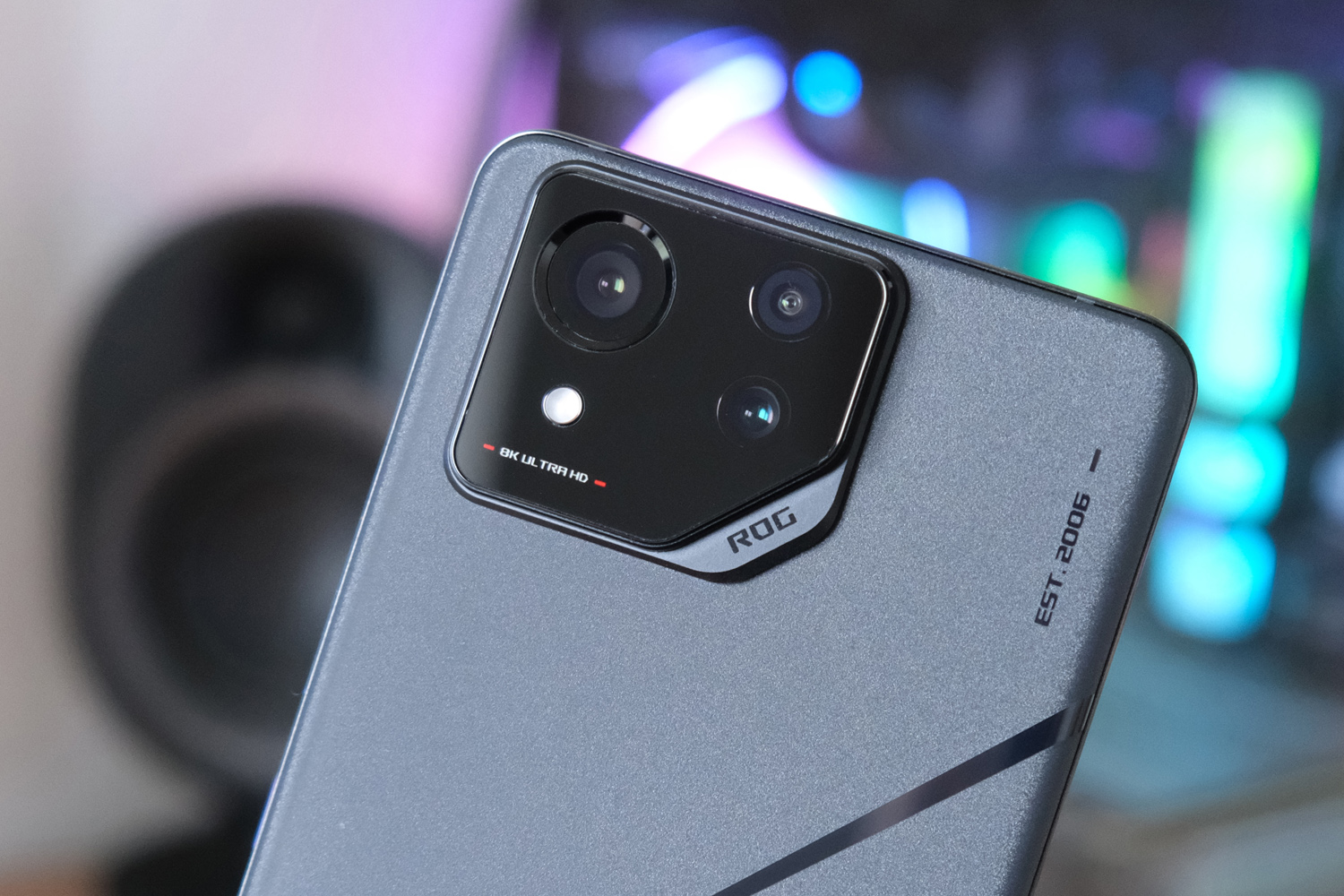
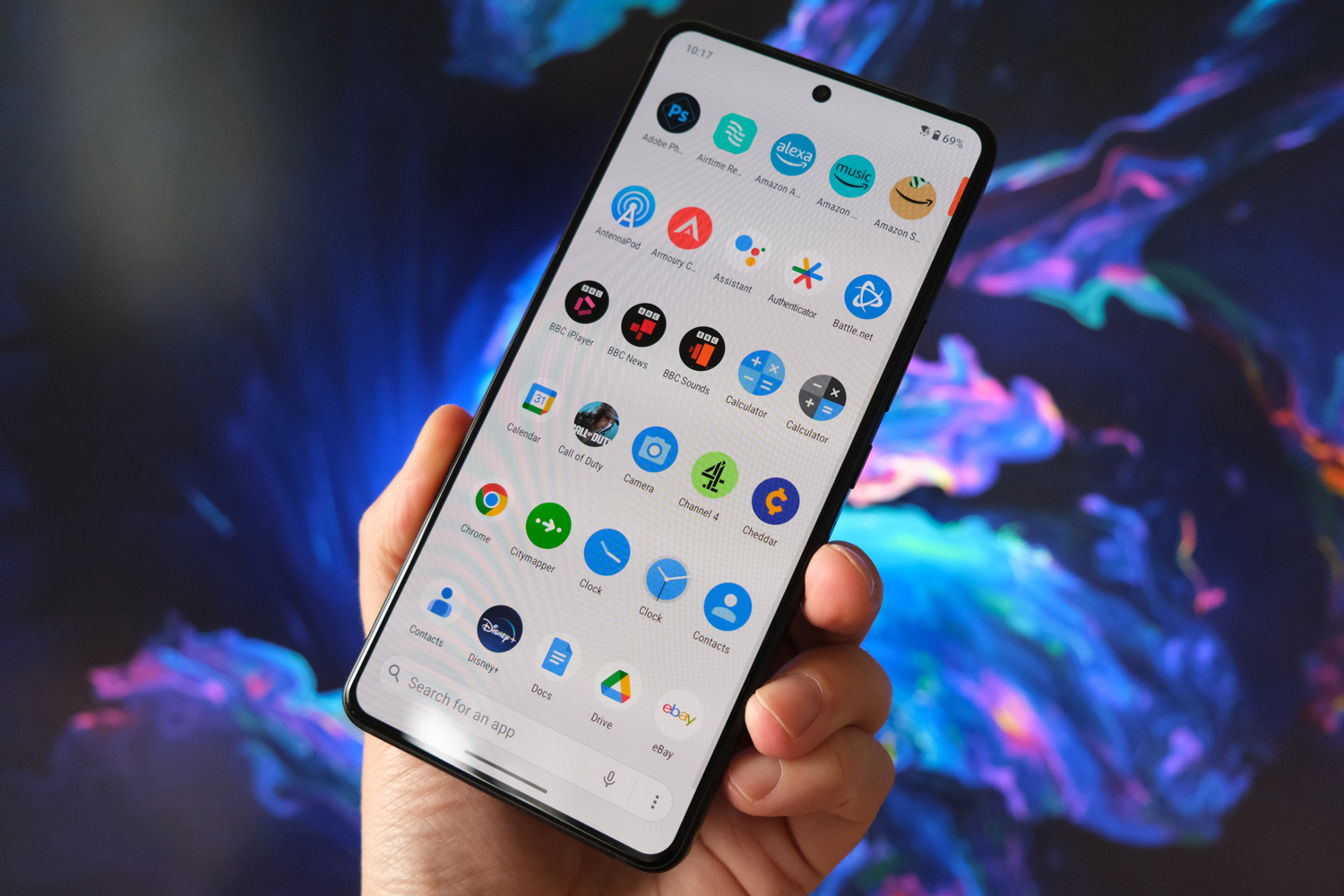
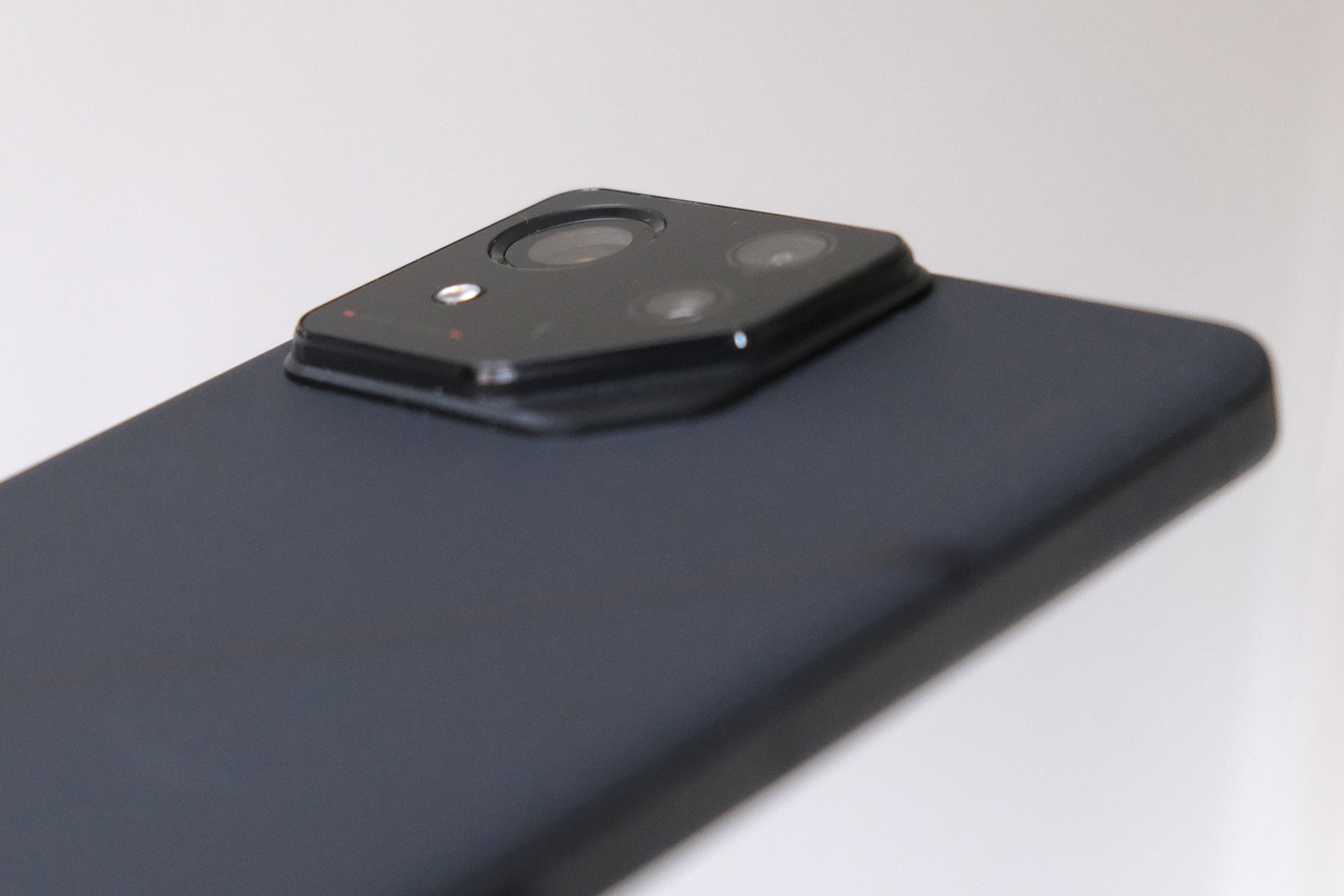
Last year’s ROG Phone 7 put in a decent performance with its main snapper, but a mediocre macro cam and no telephoto meant it fell behind more mainstream rivals. The ROG Phone 8 Pro looks to remedy that with a dedicated zoom lens. A 32MP sensor brings 3x optical zoom, with optical image stabilisation to keep camera shake to a minimum. It can also handle 10x digital magnification using sensor cropping.
Elsewhere the lead camera again uses a 50MP sensor with OIS and f/1.9 aperture lens – only now there’s a 6-axis gimbal providing more effective stabilisation. It’s paired with a 13MP ultrawide, which as a 120-degree field of view and f/2.2 glass. The 32MP front-facing camera has been given a wider field of view now, too – 90 degrees, up from 73 degrees on the previous-gen phone. All four sensors benefit from another year of image processing enhancements and a greater use of computational photography.
During the day, the main camera takes very respectable shots. Colours appear natural and there’s a good amount of surface detail on show. The HDR algorithms work hard, but can’t always avoid highlight clipping, and can result in low-contrast images. There’s evidence of oversharpening once you start peeking at pixels, too. It’s a step behind anything Google, Apple or Samsung is doing right now, but still a very decent showing considering this is primarily a gaming phone.


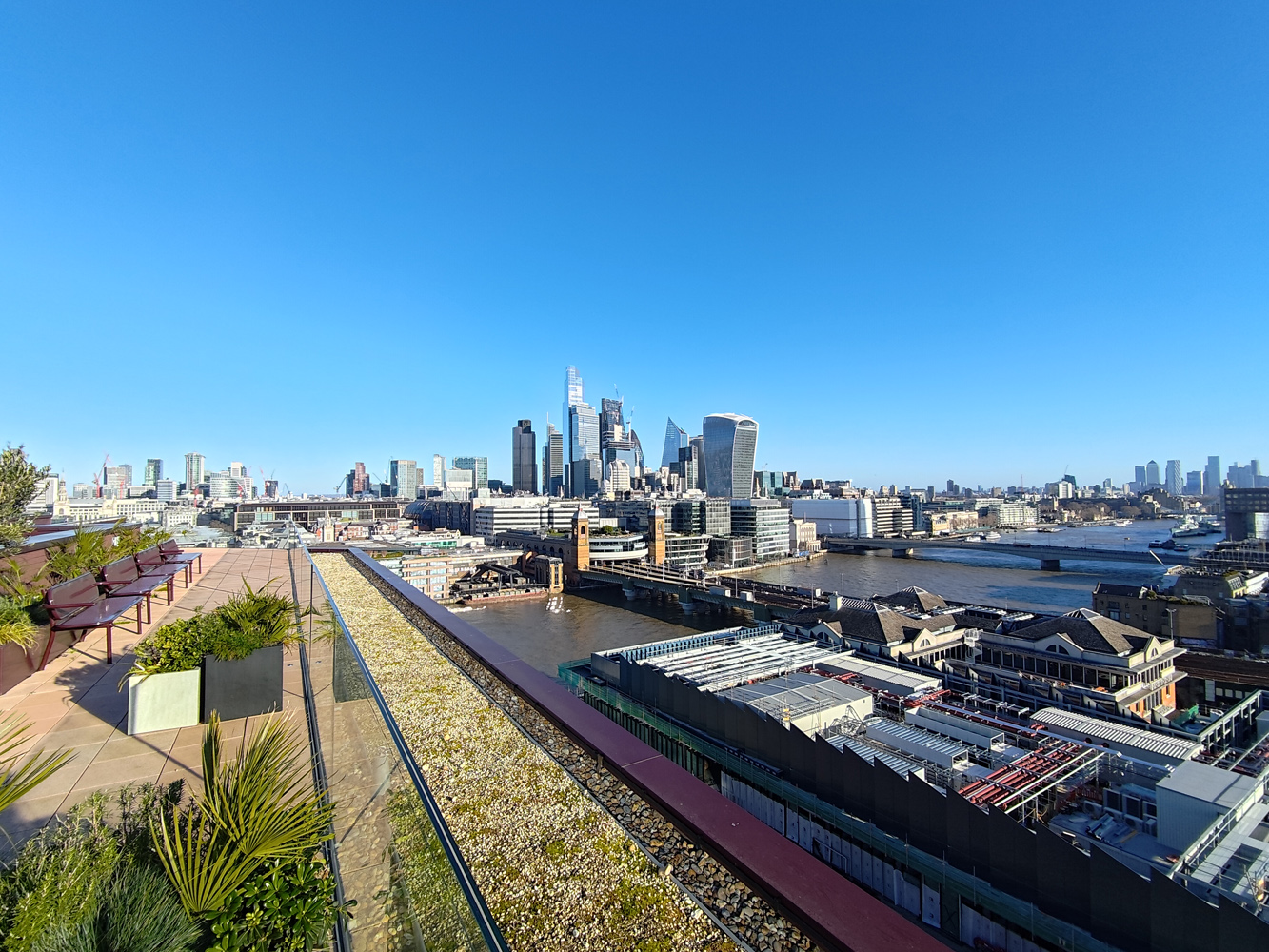















Cropped 2x zoom shots taken using the main sensor hold up very well, but 3x snaps using the dedicated telephoto are considerably cleaner. Sharpening is dialled back a bit and dynamic range is handled brilliantly. Noise is well controlled and colours are largely in line with the lead camera, if at times a little warmer. I found it produced more visually pleasing shots, so used it a lot more than I was expecting. Digital zoom can pull off pretty convincing 10x shots, but anything further just reveals the limitations of Asus’ image processing.
The ultrawide sensor does a better job of matching the main camera’s colour output, and avoids any dramatic fisheye or distortion effects at the edges of the frame. Definition takes a hit, but not so much I avoided using it.






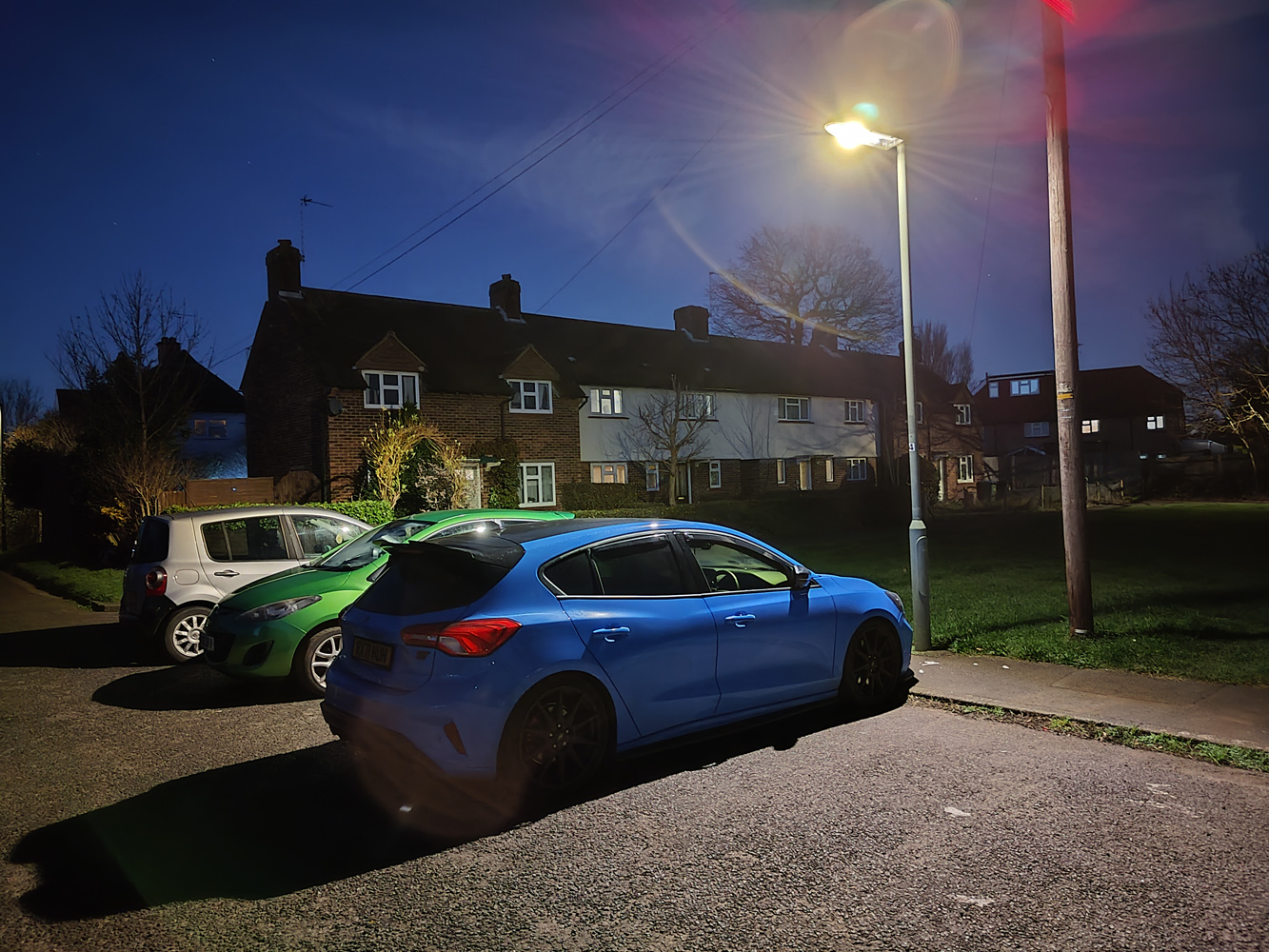

Low light performance was more varied across the board. The gimbal stabilisation helps the main sensor avoid the dedicated Night mode for particularly well-lit shots, but those make it easy to spot evidence of heavy noise reduction and sharpening. I found I got better results by forcing Night Mode on, even if it meant holding steady for a second or longer exposure time.
The zoom lens is allowed to snap quite happily in much darker environments than I was expecting. Other phones will default to the larger main snapper and simply crop in, but that’s not the case here. Images can look notably darker as a result, but noise is handled pretty well. Distant subjects were still a challenge to keep crisp, though.
Overall the ROG Phone 8 Pro falls behind mainstream flagships, but this is easily the best dedicated gaming phone I’ve used for photography.
Performance: game on
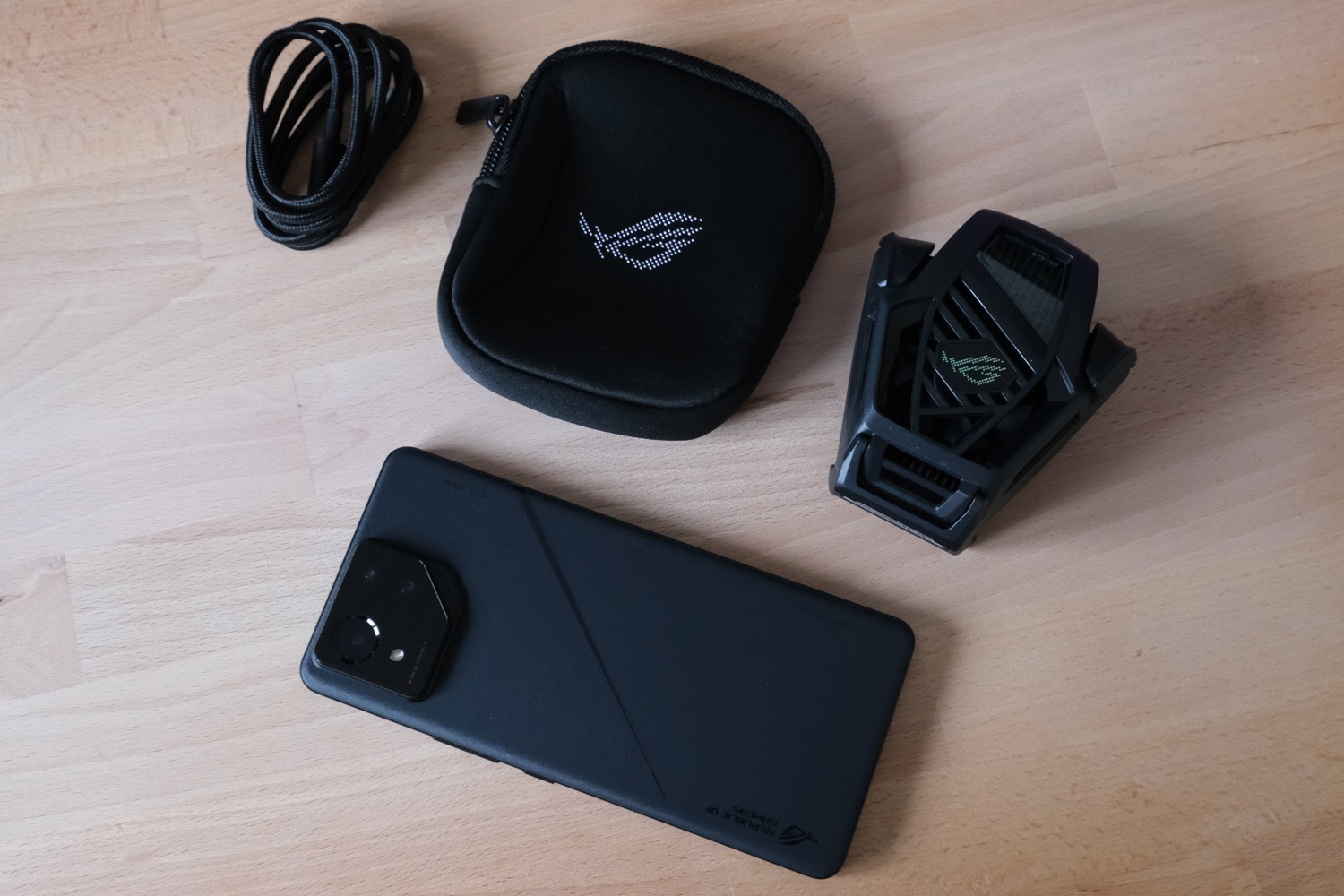
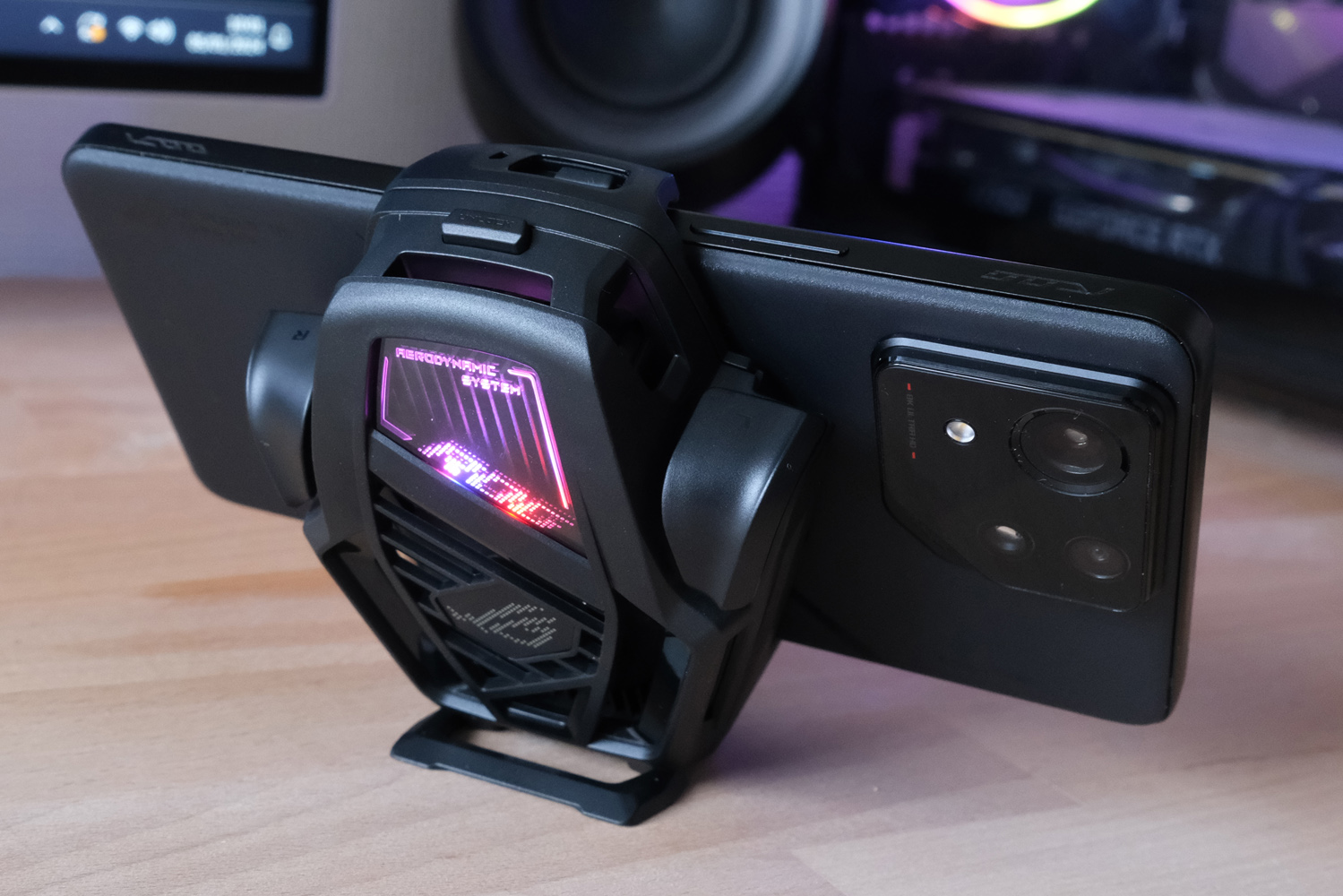
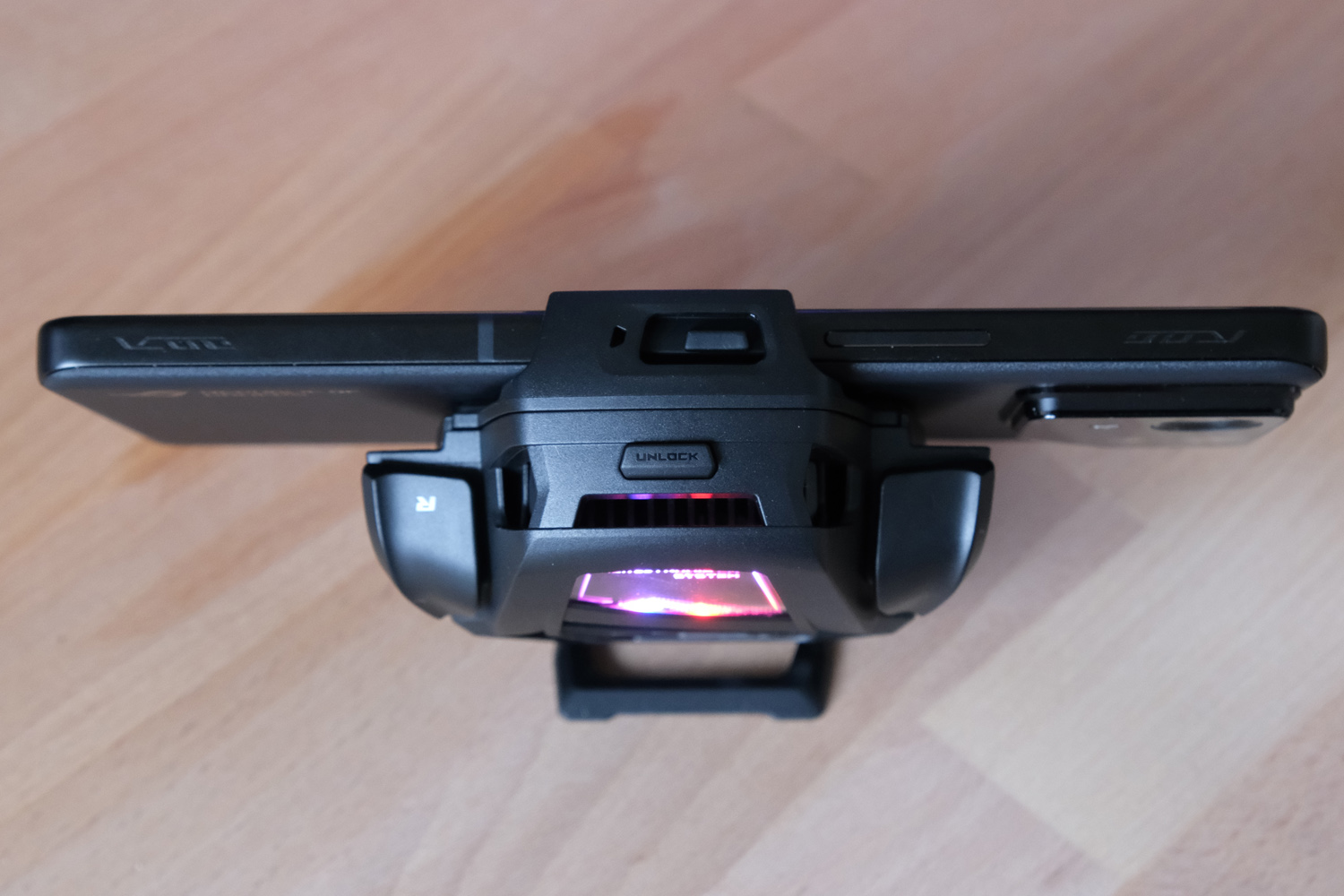
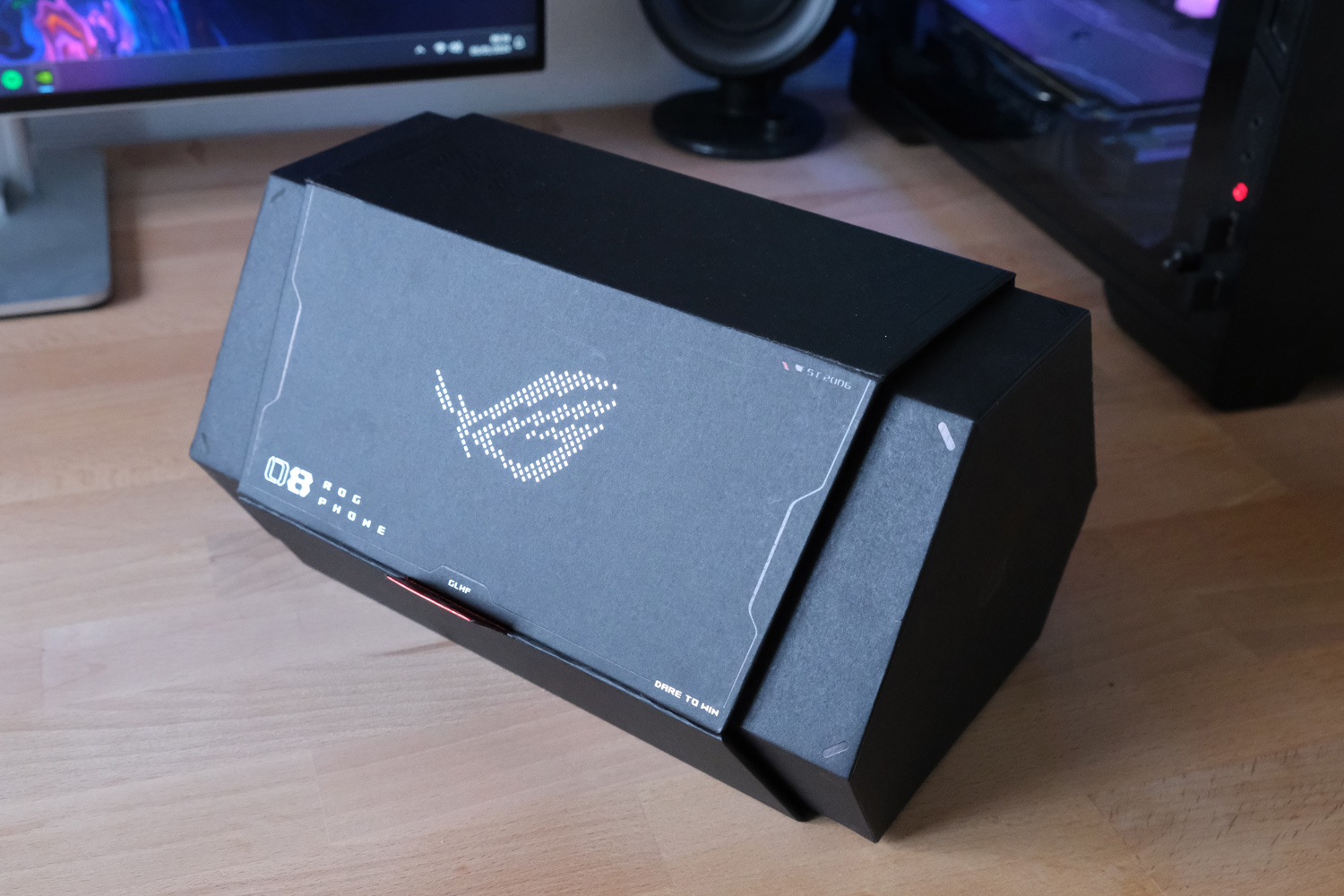
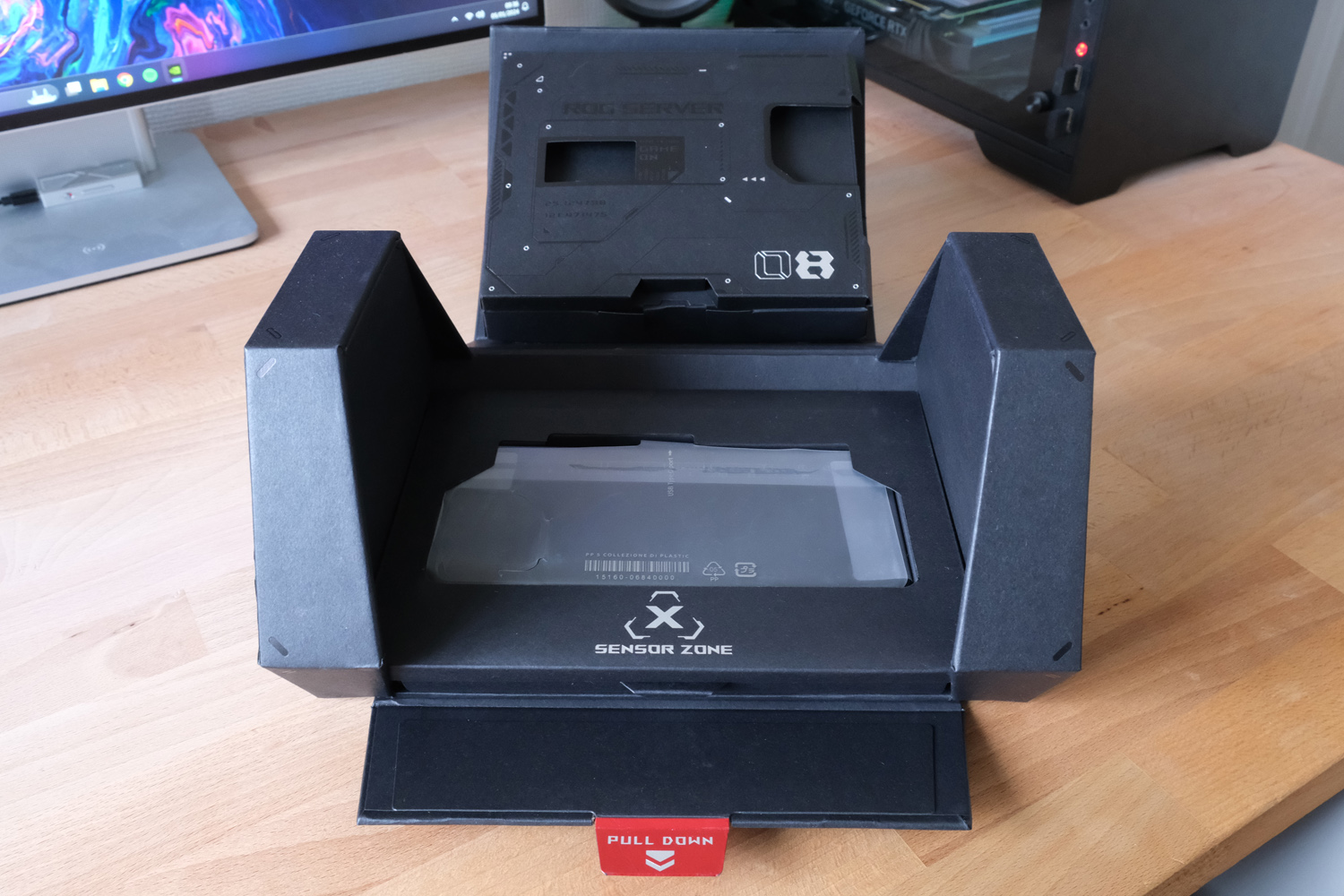
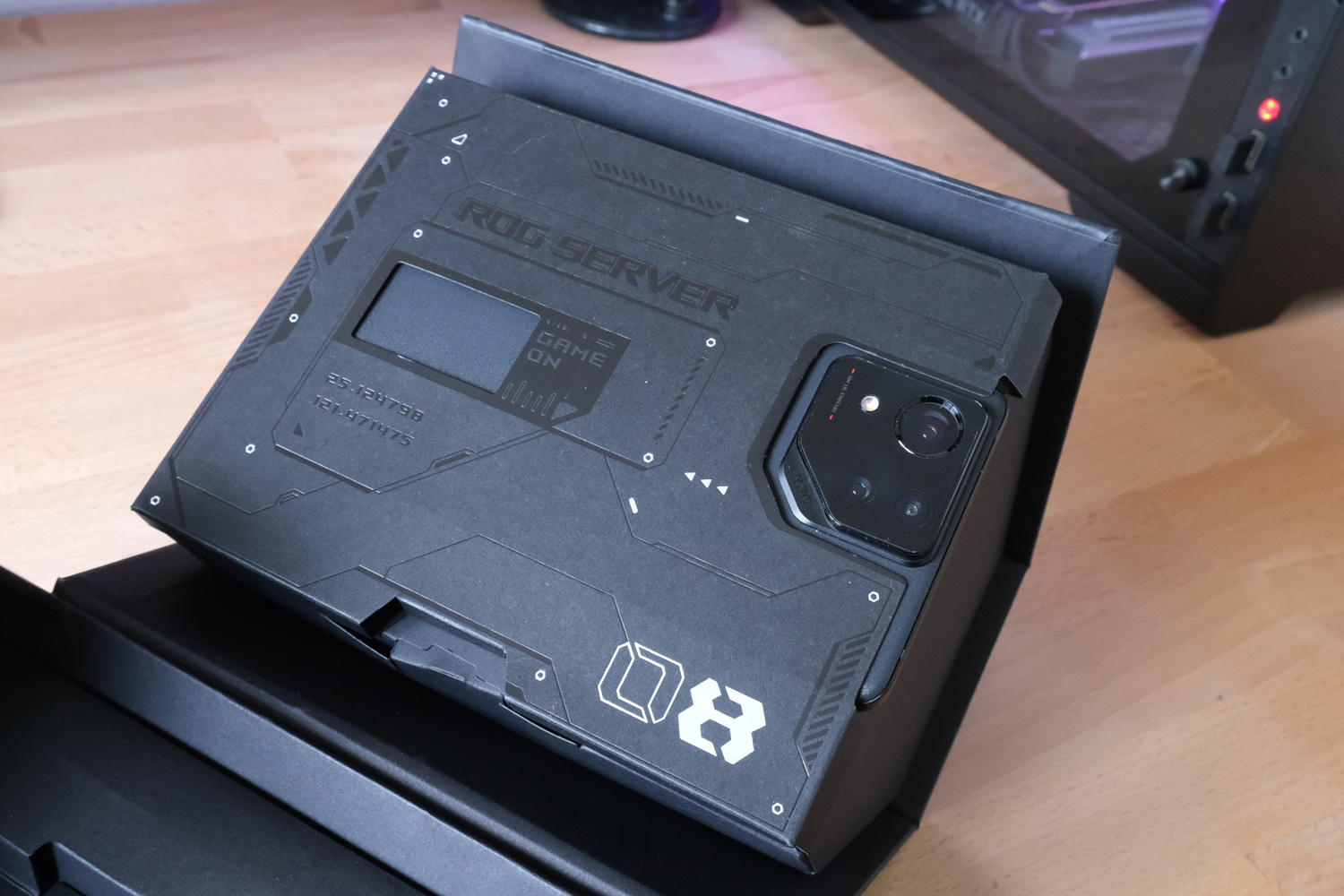
The Snapdragon 8 Gen 3 chipset inside the ROG Phone 8 Pro is Qualcomm’s most powerful mobile chip to date, and one that produces some epic benchmark results. Apple’s ridiculous (and ridiculously optimised) own-brand silicon aside, I’ve not seen any phone score significantly higher.
Pick up a regular ROG Phone 8 and you’ll get 12GB of RAM and 256GB of storage – both healthy amounts given the £950 asking price. An ROG Phone 8 Pro steps things up to 16GB and 512GB respectively for £1100, putting it firmly in flagship territory. The ROG Phone 8 Pro Edition, available exclusively from the Asus web store, treads into money-no-object territory, with 24GB of RAM and a massive 1TB of storage. Oh, and an AeroActive Cooler X included in the box. Just be prepared to part with £1300 for the privilege of owning one.
I only had the Pro Edition to test, so naturally it had no trouble keeping multiple apps in that giant memory pool. Apps opened rapidly, Android was nigh-on flawless, and games all defaulted to their highest possible graphics settings. Sustained performance was superb, even in the uncompromising X Mode power profile, although the handset got rather toasty after about 20 minutes. The AeroActive Cooler quickly fixed that. I was sad to see it lose the built-in subwoofer from last year, though, and it has two fewer programmable buttons.
My biggest issue is that rival phones with Snapdragon 8 Gen 3 chips are practically on par with the Asus performance-wise, despite having nowhere near the cooling nous. Unless you’re playing for hours at a time, you’re unlikely to notice a huge difference to frame rates. That said, you’d be missing out on the excellent air triggers by shopping elsewhere; these make action games much more fun by freeing your fingers from the touchscreen.
As usual, Asus has heavily skinned the ROG Phone’s version of Android – but does give you the option to stick with Google’s more familiar UI during initial setup. I think the ROG icons are a little OTT, all angles and dark colours, so I went with the regular Android ones. It’s a similar deal with the numerous shortcut menus and quick toolbars, but I like that you can pick and choose which get Asus’ treatment and which use Google’s.
The firm’s usual selection of baked-in software is headlined by Armory Crate and Game Genie, which will be the first stop for gamers. The former is a one-stop shop for customising the controls and power profile for each one of your games; the latter appears in-game with shortcuts for more on-the-fly adjustment. I found both comprehensive yet easy to get around, and very handy for activating do not disturb while in a hectic Call of Duty Mobile match.
It’s a shame Asus isn’t promising better long-term support. Two major Android generations and two years of security updates really isn’t very much on a phone that costs four figures – especially now rivals using the same Qualcomm CPUs are promising as much as seven years of patches.
Battery life: day tripper
On paper, the 5500mAh battery is a step down from last year’s ROG Phone 7 Ultimate, which made room for a 6000mAh total capacity. Something had to go in order to slim the handset down so dramatically, but given the Snapdragon 8 Gen 3’s greater efficiency, this is still a long-lasting handset.
In fact, there’s only a minor difference in daily use between both phones, with both going all day when I stuck to my usual use patterns. That meant social scrolling, YouTube playback, music streaming over Bluetooth, web browsing and camera use, with only a short gaming spell over lunchtime. It’s comfortably on par with the current crop of flagships. More demanding 3D gaming naturally saps juice at a much faster rate, though, so you may want to keep the bundled power brick handy if playing on the move.
I saw a 0-100% refuel in just under 40 minutes, courtesy of the 65W adaptor. 15W wireless charging is also a welcome inclusion, but there’s no Qi2 magnetic charging magic here.
Asus ROG Phone 8 Pro verdict
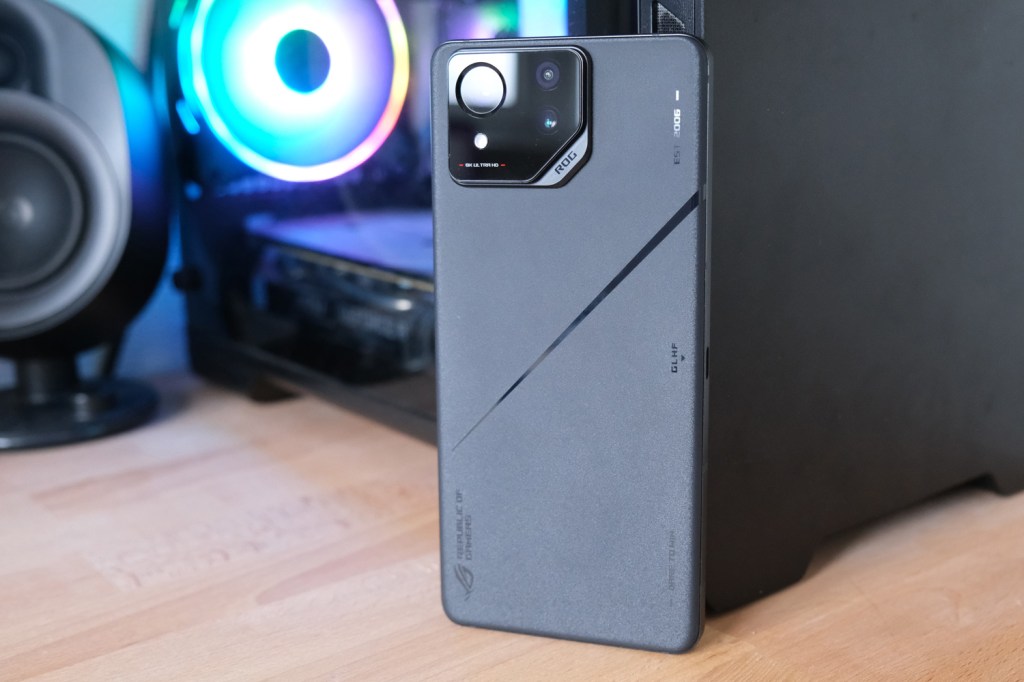
Having tested multiple generations of ROG Phone, it was obvious to me that Asus has the whole “gaming phone” thing down to a fine art. This 2024 iteration brings changes meant to appeal to a wider audience than just hardcore mobile gamers – but not all are outright successes.
The slimmer dimensions, subtler styling and stealthy LEDs make this a more grown-up handset for sure. But ditching the dual front-facing speakers and adding a punch-hole camera will court controversy with owners of older ROG phones. As much as the cameras are a big step up from last year, they’re still not on par with similarly-priced all-rounder flagships – and those phones can deliver similar gaming performance if you’re not playing for hours at a time. Serious players will love the dual USB ports, external cooler and Air Trigger controls, though.
If gaming matters most, but you felt previous ROG Phones were a bit too one-dimensional to make your only smartphone, you’ll find plenty to like about this latest version.
Asus ROG Phone 8 Pro technical specifications
| Screen | 6.78in, 2448×1080 AMOLED w/ 165Hz, LTPO 1-120Hz |
| CPU | Qualcomm Snapdragon 8 Gen 3 |
| Memory | 12/16/24GB |
| Cameras | 50MP, f/1.9 w/ 6-axis gimbal + 13MP, f/2.2 ultrawide + 32MP, f/2.4 telephoto w/ 3x optical zoom rear 32MP front |
| Storage | 256/512GB/1TB |
| Operating system | Android 14 |
| Battery | 5500mAh w/ 65W wired, 15W wireless charging |
| Dimensions | 164x77x8.9mm, 225g |


